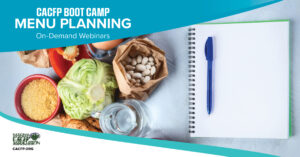Boot Camp
Adapting Menus for Special Diets ($)
Are you wondering how to navigate food allergies and create safe meals for the children in your care while participating in the CACFP? Learn the differences between various types of special diets and how to prepare these foods to meet CACFP guidelines. Know what a meal modification is, how to serve modified meals, and how to navigate through meal modification scenarios.
Read MoreUsing the Food Buying Guide for Menu Development ($)
Unlock the full potential of the USDA’s Food Buying Guide (FBG) for Child Nutrition Programs. Learn how to access the FBG, create an account, and utilize its tools to plan nutritious, compliant, and cost-effective meals. We’ll guide you through the FBG yield tables, meal components, and selecting the right food items for your recipes. Don’t miss this chance to streamline your meal planning and ensure dietary guidelines are met with ease!
Read MoreProcuring Local Foods for Child Nutrition Programs ($)
From beef and bison in Montana to apples in Michigan and radishes in Rhode Island, local foods are on the menu for children across the country. Local procurement not only supports increasing economic opportunities for local farmers, but also helps child care institutions incorporate wholesome local foods into program meals and encourages children to make healthy food choices. Learn how local foods can meet meal pattern requirements, understand what is required when purchasing local foods, and get the resources you need for procuring them.
Read MoreMenu Planning: Your Guide to Success ($)
Do you love menu planning or are you unsure where to begin? Learn what to consider when developing a cycle menu or planning meals one week at a time. Receive new, easy recipe ideas that are sure to become favorites at your center or in your family child care home! Identify the differences between a cycle menu and weekly menu. Explore the step-by-step process of menu development, from concept ideation to finalization.
Read MoreMeal Pattern Basics ($)
Centers, family child care homes, and after-school care play a critical role in serving nutritious foods to those they serve. The CACFP guides you on how to provide healthy meals using five meal components which make up the meal service requirements: grains, fruits, vegetables, meats/meat alternates, and milk. Learn when these are required and how they fit into the CACFP meal pattern.
Read MoreBest Practices for Budgeting for Meals & Snacks ($)
Every penny counts at child care centers and family child care homes. Discover the secrets to stretching your CACFP budget without compromising on quality. Gain fun, practical tips on planning, purchasing, and preparing nutritious, high-quality meals that kids will love—all while staying within budget. Learn how to make the most of your resources and create delicious, healthy meals that are both budget-friendly and nutritious.
Read MoreSummer Food Service Program Basics ($)
Don’t know what SFSP even means? Are you brand new to child nutrition food programs? Do you run one program and are thinking about sponsoring another? Learn how this food program provides healthy food access for children in child care, afterschool, out-of-school time and during summer.
Read MoreSponsoring Summer Food: Keys to Financial Management ($)
You’re already working the food program and are ready to expand to summer feeding. Hear about best practices to ensure proper internal controls for successful financial management and mitigate high risk program areas. Identify key SFSP Financial Management Requirements. Discover strategies for existing programs to include SFSP. Acquire best practices to prevent common internal control weaknesses.
Read MoreRural, Non-Congregate Summer Food Service: Policy Update and Best Practices ($)
When school ends and summer begins, students who live in rural areas often experience food insecurity and sometimes have no access to healthy foods at all. Schools or parks may be up to an hour or more away from where they live and parents or caregivers simply can’t get them to SFSP sites. Learn how real programs adopted this meal service option for rural areas to better serve their community and feed hungry kids. We’ll also cover an overview of the latest policy updates, such as the recently released Interim Rule for Non-Congregate Feeding option.
Read MoreFrom Hot to Cold: Create an Award-Winning SFSP Cold Lunch Menu ($)
Cold meals can be high-quality, healthy and reach children in a variety of non-traditional settings. Learn how to work with key community partners to bring cold meals to the Summer Food Service Program. Presented by a 2017 Silver and 2018 Gold USDA Turnip the Beet award winner.
Read More

